All products featured are independently chosen by us. However, SoundGuys may receive a commission on orders placed through its retail links. See our ethics statement.
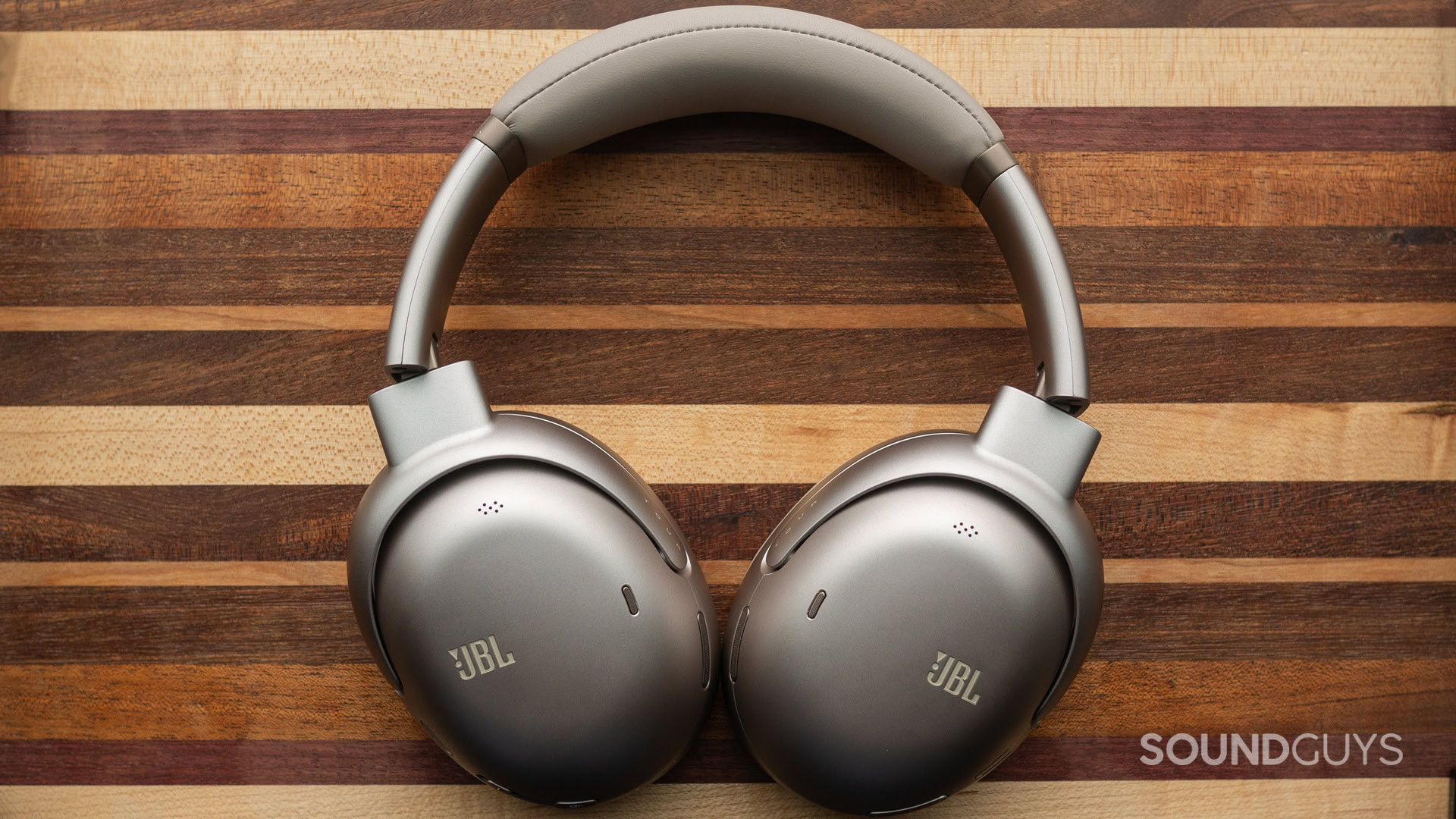

JBL Tour One M3 review: The next generation of ANC
April 15, 2025


JBL Tour ONE M3
Weight: 275g
The world of high-end ANC headphones is dominated by only a handful of options, and is ripe for a shakeup. But can personal audio behemoth JBL force its way into the conversation? We were able to test out the JBL Tour One M3 for a week before it released to find out. One thing’s for sure: people will be talking about it.
The JBL Tour One M3 is for anyone looking for top-tier noise canceling headphones with the latest features, but is not enticed by the Bose, or Sony options.
- This article was updated on April 15, 2025, to discuss the final battery testing results, and add the score.
- This article was updated on April 14, 2025, noting the battery test has eclipsed 48 hours of continuous playback.
- This article was published on April 11, 2025, without final battery scores or fiures.
What’s it like to use the JBL Tour One M3?
The JBL Tour One M3 is meant to slot into your life as a complete daily driver. As it’s a set of higher-end active noise canceling (ANC) headphones with just about every feature most people would ask for, it’s a credible competitor to the AirPods Max, Bose QuietComfort Ultra, and Sony WH-1000XM5s of the world. Kitted with 8 microphones with windscreens, up-to-snuff signal processing with an internal DAC, and 40mm drivers, the JBL Tour One M3 has all the parts to be a top-flight set of ANC headphones.
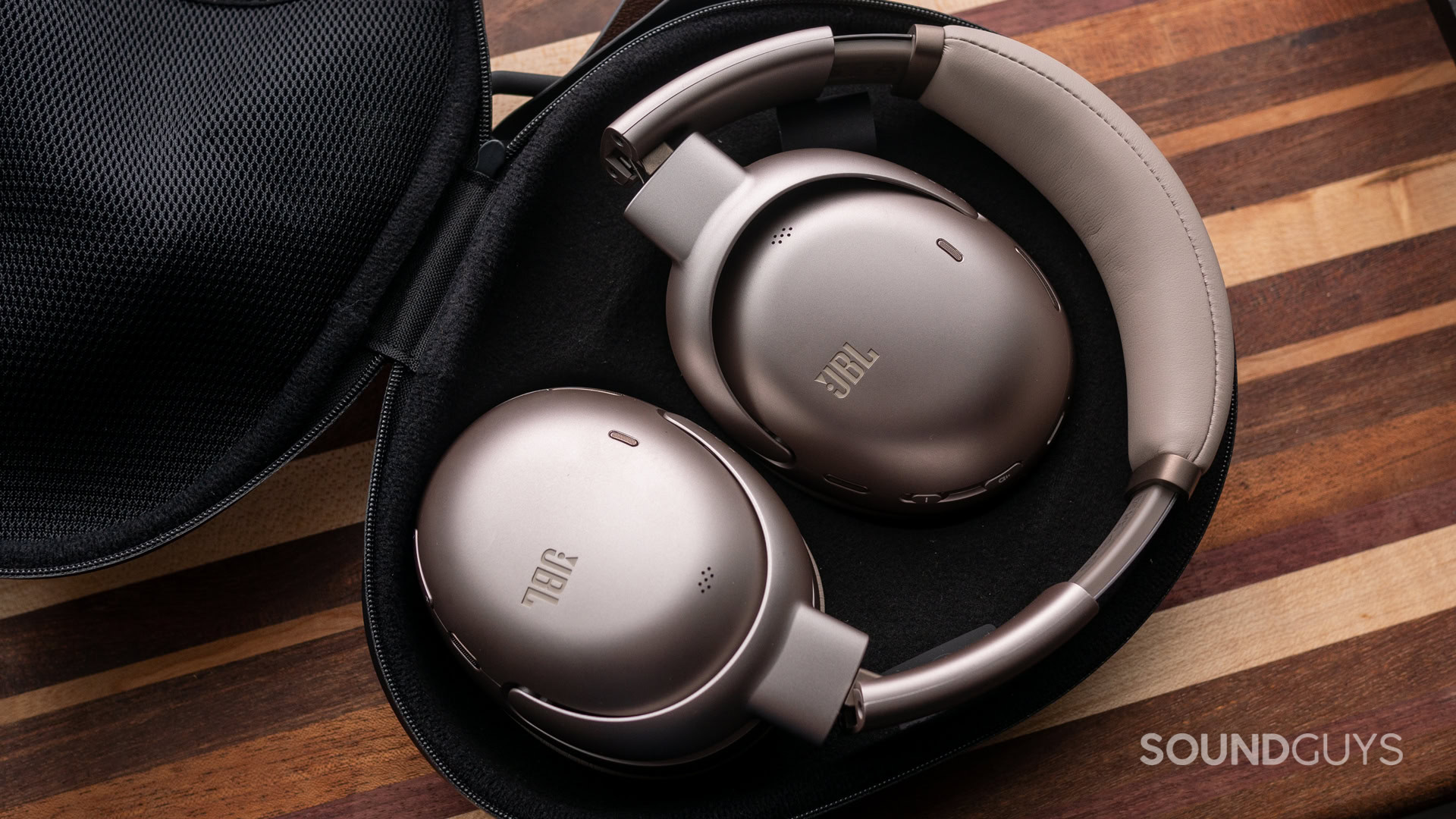
Using the JBL Tour One M3 is fairly forgiving, as we’ve reached a point in headphones history where we’ve settled pretty uniformly on what makes a good set of headphones. There aren’t really any surprises with the build of the JBL Tour One M3: the faux leather ear pads are comfortable, the plastic build is mercifully light, and the band of the headphones is adequately padded for longer listening sessions. I found the JBL Tour One M3 to be just as comfortable to wear as any of the other top-end ANC headphones on the market, though those of you with smaller heads may struggle a bit to get a decent fit with the band.
But the most unique feature is the SMART Tx remote and transmitter. Said transmitter is essentially a carbon copy of the system used by the JBL Tour Pro 3: you can control your headphones’ performance and playback with the brick while also using it as a transmitter to listen to audio over a low-energy codec. The brick has a charging port on the right of the unit, and a USB-C input to the left. A capacitive screen on the front serves as the only control interface as well.
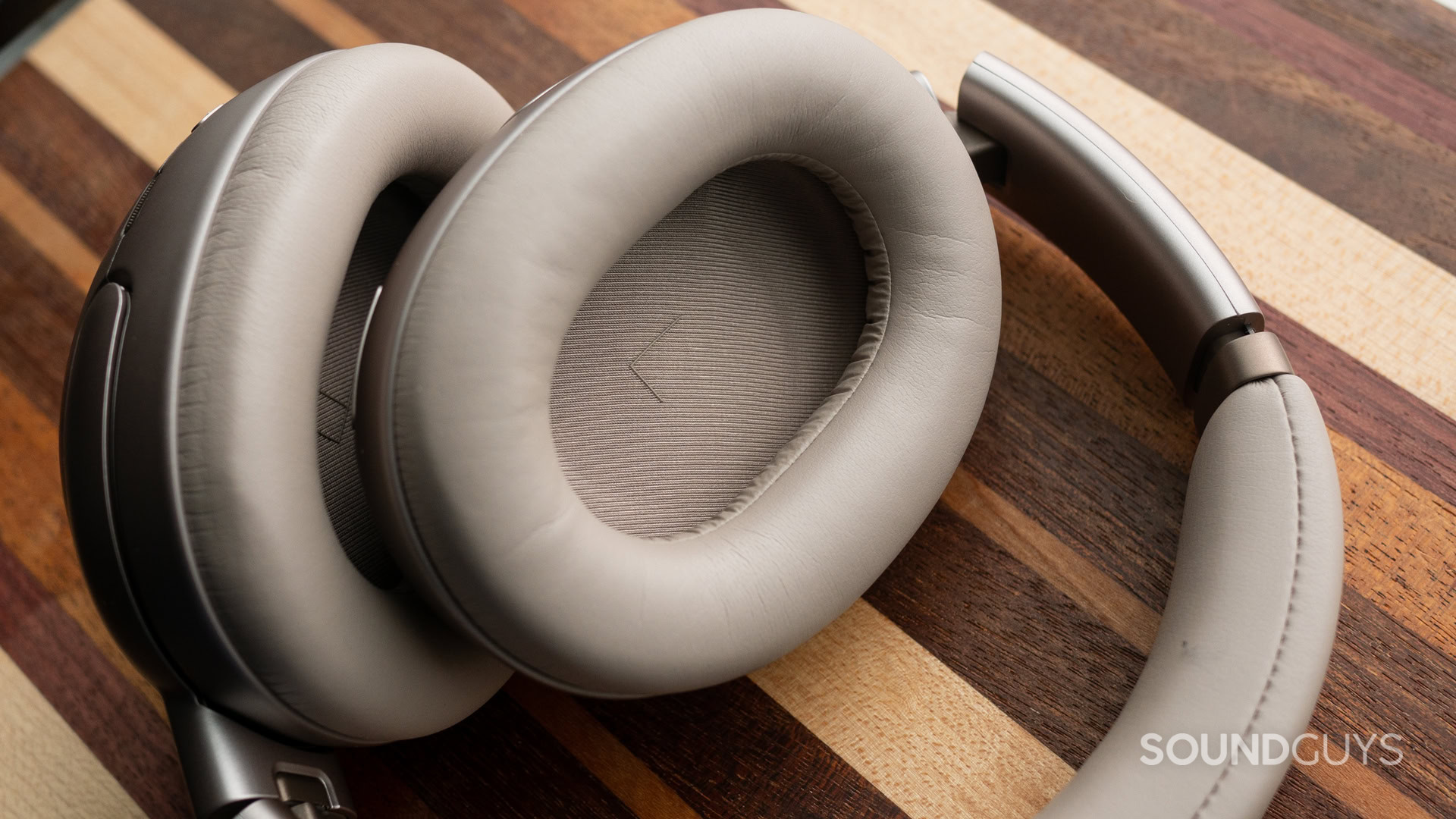
The JBL Tour One M3 comes stuffed into a carrying case that’s thankfully slim, though it requires you to use the headphones’ ability to lie flat and fold up. On the top shell lid is a mesh pouch, where I suggest you keep the included USB-C and 3.5mm cables stowed — they’re really easy to lose. This case is perfect for air travelers, as its flat design makes it less of a pain to keep in your carry-on, and it shouldn’t get caught on the seat when it gets shoved under the one in front of you.
As far as advanced features go, the JBL Tour One M3 has pretty much all of them. Find My, Spatial Audio, a volume limiter, customizable passthrough and vocal modes, ear detection for auto-pause… the list goes on. For those who need to chill out sometimes, there’s even a set of relaxation tracks that you can play through the app for a preset amount of time.
The JBL Tour One M3 uses a blend of physical buttons and a capacitive touch plate. On the left ear cup is a volume rocker, and the right earcup has the capacitive touch plate, ambient sound toggle, plus power slider.
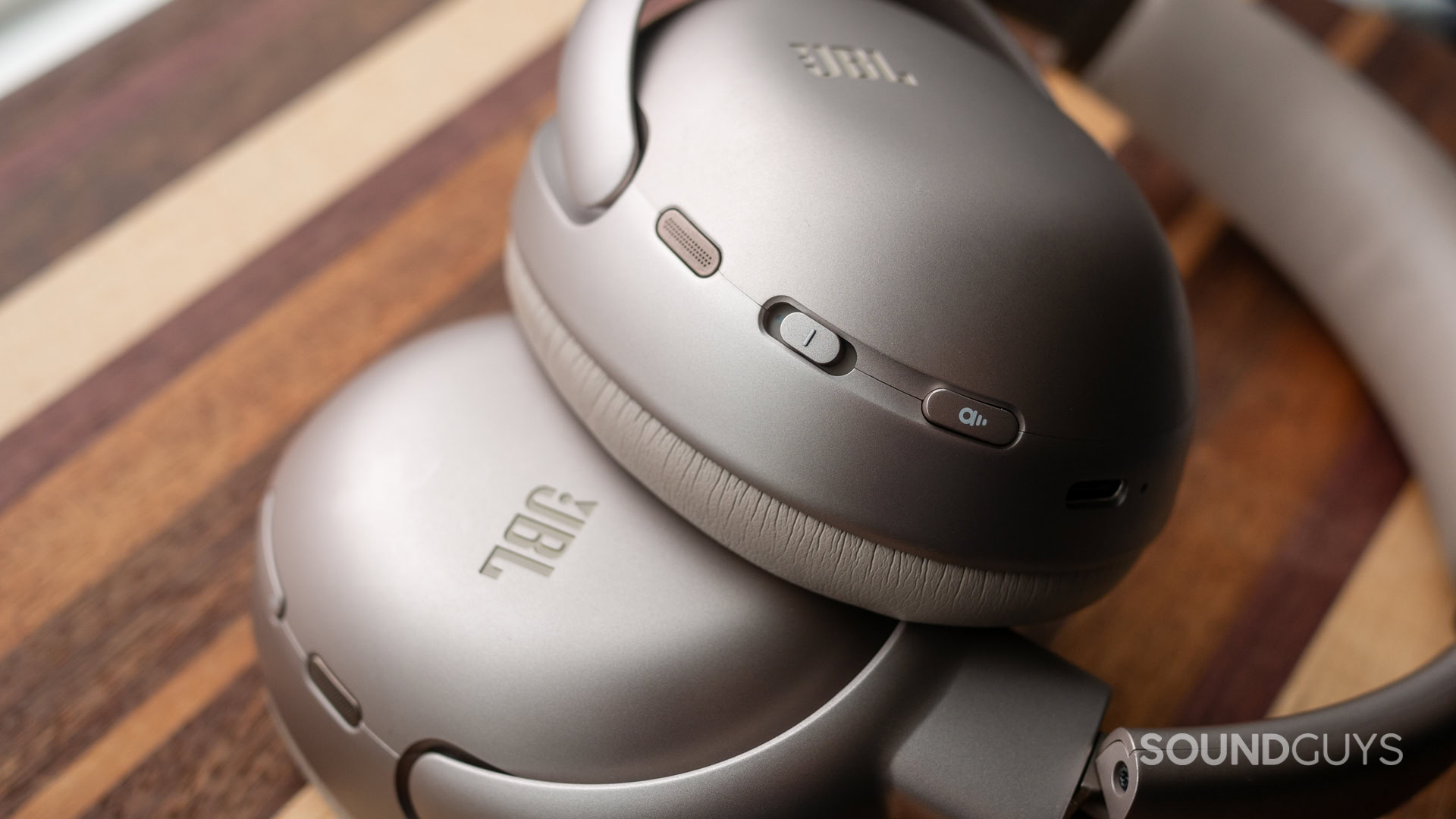
Touch controls:
| Input | Right earcup |
|---|---|
Single tap | Play / pause |
Double tap | Next track |
Triple tap | Previous track |
Long press | Voice assistant |
What are the best features of the JBL Tour One M3?
The best feature of the JBL Tour One M3 by far and away is the JBL SMART Tx remote brick — despite my colleagues’ reticence. Though it can be a bit of a pain to have yet another thing to lose in your pocket, it’s convenient to be able to avoid opening your phone to access an app. Instead, you just flip out this tiny little brick to access the advanced features of your headphones and music playback. Like the smart case of the JBL Tour Pro 3, the brick is much more than that.
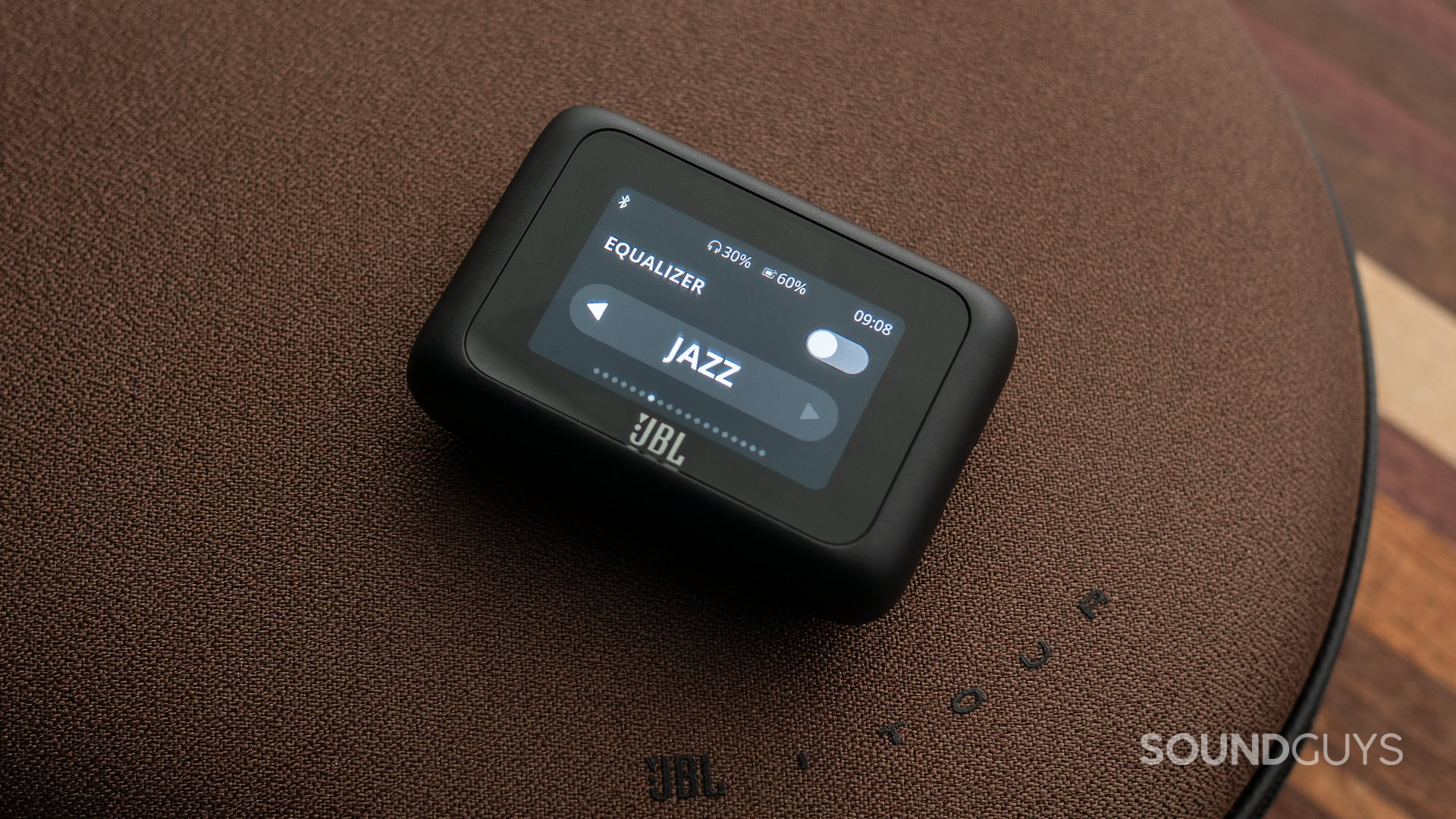
If you find yourself with a source that doesn’t support wireless, or is just locked behind some walled garden BS like Apple devices: you can simply use the JBL SMART Tx as a transmitter to sidestep the issue. By offloading the processing and transmitting to the brick and not relying on the source device’s hardware to handle everything, you can safely forget about what compatibility issues or shortcomings you might have with this brick. The main drawbacks are that it’s easy to lose, and it’s yet another thing that needs charging.
The transmitter allows you to pair multiple Auracast-compatible devices to it — several at a time, too. If you’re traveling with family, you could all listen in on a movie or show at the same time, provided each of your headphones supports Auracast. This fits in with the company’s strategy to move away from proprietary solutions for multi-device setups, and this is a big check in the plus column. By enabling this sort of flexibility, the JBL Tour One M3’s success could drag other manufacturers into doing the same.
I was very heartened to see JBL add a personal sound amplification (PSAP) feature
So far, this is my favorite implementation of the capability, and it’s a shame that it’s not making more headlines yet. Being able to start your own shared broadcast over LC3 is such a game-changer for traveling families, friend groups, or people simply looking to tap into a single source of entertainment is going to be one of those things that we take for granted in the future, but was an unbelievable pain in the butt in the early days of wireless. Hurdles like these disappearing is always a good thing, especially when it was a capability we lost with the death of wired headphones. I’m still not wild about an easily-lost accessory being integral to any product, but maybe replacement bricks will be affordable.
Finally, I was very heartened to see JBL add a personal sound amplification (PSAP) feature, which helps the JBL Tour One M3 blur the line between headphone and hearable. By adopting hearing assistive features for the mass market, products like the Apple AirPods Pro 2 and the JBL Tour One M3 are making some of these capabilities available to people without buying separate equipment. Just head into the app et voila! you can turn the transparency mode into a legit means to hear the world around you better. This also helps side-step the stigma associated with wearing dedicated PSAP devices or hearing aids, and I will always laud that. Good on ya, JBL; well done.
How does the JBL Tour One M3 connect?
Over its Bluetooth 5.3 connection, the JBL Tour One M3 can connect to your devices via SBC, AAC, LDAC, and LC3. Additionally, the headphones support Auracast, as mentioned above — which is necessary for the transmitter case to work. If you’re a purist, the JBL Tour One M3 also supports lossless USB-C or analog audio, enabled by the onboard DAC. Truly, these can be used with pretty much anything, and that’s a fair bit rarer than it should be. Though the high-bitrate LDAC is only available with sources that support it, the advantages of using LC3 with the transmitter are low latency and lower power draw.
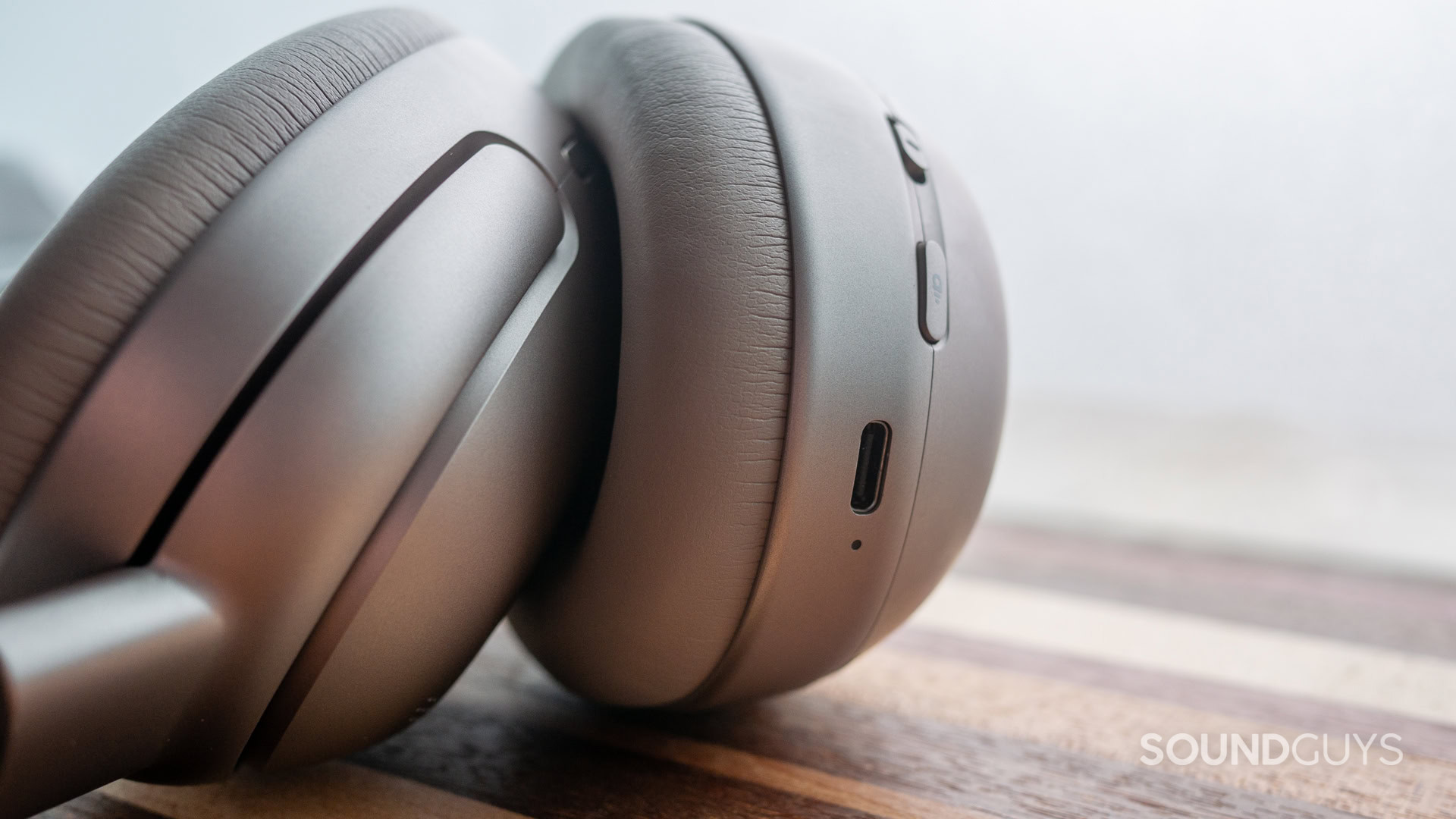
Though you’d hope that all contemporary wireless headphones should be able to handle wired input, it’s a bit more rare than you might think. It’s a very good thing that the JBL Tour One M3 gives its users both analog and digital wired options, as well as the ability to transmit audio from sources wirelessly.
The JBL Tour One M3 has fast pairing, so if your computer or phone is being difficult for any reason, you can always pair manually.
- With the headphones on your head, pull the power slider all the way down and hold it until you hear a voice say “pairing.”
- On your phone or computer, open the Bluetooth menu and hit “scan.”
- Locate the JBL Tour One M3 in the list of available devices.
- Pair.
The JBL Tour One M3 can handle digital audio decoding using its onboard hardware, so you can plug in your phone or computer directly over USB-C.
- Shove business end of USB-C cable into open port on phone or computer.
- Put other end in headphones’ charging port.
- Play music.
Since you’ll need your JBL SMART Tx for this, be sure it’s fully charged, and you have the appropriate cables with you.
- Unpair the JBL Tour One M3 from Bluetooth.
- Find the USB to USB cable, or USB to 3.5mm cable to connect to your source device.
- Plug the cable into the USB-C port with the USB symbol above it.
- Plut the other end of the cable into the source you would like to listen to.
- On the brick, swipe to the Auracast screen, and tap the icon.
- Put the headphones into pairing mode by holding the slider on the left earcup all the way down, until you hear the voice say “pairing.”
- The brick will handle the rest.
How long does the JBL Tour One M3’s battery last?
Going the distance at 55 hours and 37 minutes with the ANC on, you should have zero troubles on intercontinental flights, commutes, or even just spending a few days in the woods. The headphones will likely last longer than a full workweek of commutes and hiding from colleagues. As always, I’m a big fan of headphones that last a long time, because fewer charge cycles most often means less battery wear over time — making your headphones a little more durable for the long haul.
The SMART Tx accessory is also quite aggressive about shutting itself off when not in use, so it, too, seems to last forever. If you use the transmitter function, you can expect this to plummet a bit, but we haven’t had the opportunity to really stress this one, given that we don’t have many Auracast-enabled headphones around the office currently. I may be able to test the battery life of the SMART Tx in a future update, however.
In terms of battery life, the JBL Tour One M3 sits at the top of the pile, just narrowly falling short to the Sennheiser MOMENTUM 4 Wireless in total playback in our standardized test with real music peaking at 75dB.
- Sennheiser MOMENTUM 4 Wireless: 56:21
- JBL Tour One M3: 55:37
- Sony WH-1000XM5: 31:53
- Bose QuietComfort Ultra: 27:37
- Apple AirPods Max: 20:00
Given that the result is so close to the top, I’m pretty comfortable in saying that most people will accept this result happily.
How well does the JBL Tour One M3 cancel noise?
If you’re looking for a top-flight set of noise cancelers, the JBL Tour One M3 is one of the best options on the market. Owing in part to excellent isolation, the JBL Tour One M3 posts one of our highest ANC scores as well.
Loading chart ...
Actively canceling around 30dB of outside noise under 1kHz and isolating everything above it excellently, the JBL Tour One M3 is every bit a contender for the best ANC headphones on the market as any other model. While JBL isn’t exactly an unknown quantity by any means, it hasn’t really been in the conversation of top-tier ANC headphones for a long time. That should change with the JBL Tour One M3.
How does the JBL Tour One M3 sound?
Though the JBL Tour One M3 has its ups and downs, the sound is easy to get used to. While it’s not going to be everyone’s favorite, you can make some pretty helpful adjustments to improve the performance here.
Reviewer’s notes
Editor’s note: this review uses a hover-enabled glossary to describe sound quality based on a consensus vocabulary. You can read about it here.
Can you use the JBL Tour One M3 for phone calls?
As a competitor for the top end of ANC headphones, the JBL Tour One M3 can predictably handle phone calls like any other headset.
JBL Tour One M3 microphone demo (Ideal conditions):
How does the microphone sound to you?
JBL Tour One M3 microphone demo (Office conditions):
JBL Tour One M3 microphone demo (Street conditions):
JBL Tour One M3 microphone demo (Windy conditions):
JBL Tour One M3 microphone demo (Reverberant space):
I’m impressed. The microphone array does a great job with wind noise and echoes, so the JBL Tour One M3 should work really well to take conference calls or work in an office.
Should you buy the JBL Tour One M3?
Though it’s a little spendy, the JBL Tour One M3 is a competent competitor at the sub-$400 price point. The addition of the SMART Tx accessory might be a little controversial, but it definitely has its appeal to people with friends, family, or want to future-proof their investment in headphones. With rock-solid ANC and decent-enough sound performance, the JBL Tour One M3 should be on everyone’s radar if you’re looking for something Sony and Bose just don’t offer yet. We’re awarding these headphones not for their default sound — because you can make it better — but for their ability to serve a huge array of needs, including those hard of hearing, and those who want to use their headphones with absolutely anything.
Examining the JBL Tour family, we see two types of devices: headphones and wireless earbuds . Each line has a staggered cadence, with the headphones launching in mid-2022, early 2023, and then early 2025, indicating a pattern of roughly 1.5 to 2 years between headphone models. The earbuds followed with launches in mid-2022, spring 2023, and late 2024, showing around 1–1.5 years between models. The most recent launches are the Tour Pro 3 in 2024 and the Tour ONE M3 headphones in 2025. Based on this established rhythm, our expert analysis suggests the next JBL Tour Pro earbuds are likely to arrive between 2025 and 2026, and the next Tour One headphones potentially in 2027. With the most recent releases just happening, it's likely the next announcement won't be until at least late 2025 or after. We continue to gather reliable information to improve this prediction as the cycle evolves.
What should you get instead of the JBL Tour One M3?
If you’re hoping for a set of headphones that does all the same things the JBL Tour One M3 does currently, you’re outta luck: it doesn’t exist yet. However, the natural competitors to the JBL headset are going to be the Sony WH-1000XM5 ($387 at Amazon) the Bose QuietComfort Ultra ($429 at Amazon), and the Apple AirPods Max (on the product's website). Each of these headphones has a unique feature to bring over the rest, but none of them have the Auracast ability the JBL Tour One M3 has, nor do they separate themselves too much from the JBL in terms of raw noise canceling ability. We encourage you to try those headphones anyway, because one may fit your skull a lot better than the rest — making it the right choice for you.
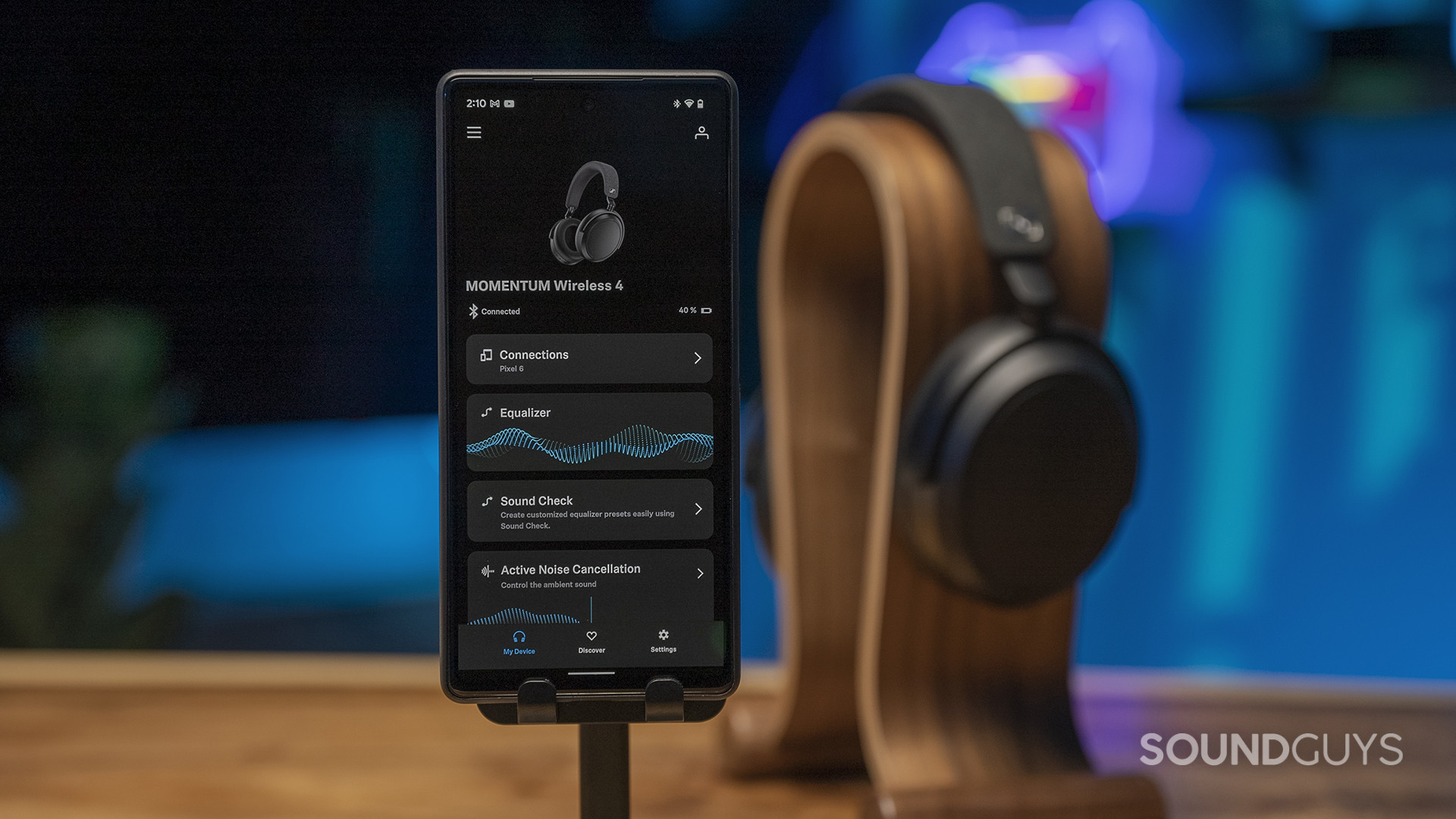
While it’s tempting to tell people to look for a cheaper alternative, there really isn’t much on the market that’s comparable without some major tradeoff or two. For example, the JLab JBuds Lux ANC ($79.99 at Amazon) are much more affordable, have wired USB listening, and decent ANC — but it lacks the featureset and future-proofing the JBL Tour One M3 has. Not to mention, the Tour One M3 runs circles around it in performance. Similarly, the Sennheiser MOMENTUM 4 Wireless ($289.23 at Amazon) is very similar in many ways to the JBL Tour One M3, but has poorer ANC at roughly half the price.
JBL Tour One M3 review: FAQs
Yes.
I would only use the JBL Tour One M3 for gaming if you're using it in wired mode.
There is no ingress protection rating listed for the JBL Tour One M3.
Without an ingress protection rating against moisture, I wouldn't use these headphones to work out with.
Yes. Also wired.
Yes.
